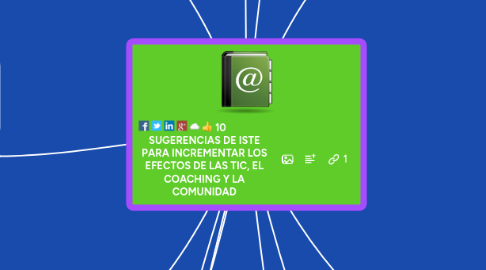
1. Introduction
1.1. La Sociedad internacional para la Tecnología en la educación (ISTE) ofrece 10 consejos para la construcción de un modelo profesional que incluye las TIC. el coaching y la comunidades.
2. APROVECHAR SU TIEMPO AL MÁXIMO
2.1. Es necesario pensar muy positivamente en establecer un proceso que funcione dentro del presupuesto y las variables de tiempo establecidas.
3. COMPARTIR SU PROGRESO
3.1. El éxito se da en la medida en que los profesores en realidad están aplicando lo que están aprendiendo.
3.1.1. es crucial tener un plan de comunicación activa para reportar progresos y éxitos.
4. APRENDER CON LAS TIC ES MÁS IMPORTANTE QUE APRENDER ACERCA DE LAS TIC
4.1. Incrementar habilidades
4.2. i
4.2.1. Incrementar el aprendizaje en todas las competencias y áreas temáticas/asignaturas.
5. ASUMIR LAS TIC COMO IMPULSOR PRINCIPAL
5.1. Toda iniciativa de desarrollo profesional puede beneficiarse de la integración de las TIC. Con ellas, usted estará mejor.
6. APALANCARSE EN EL MUNDO
6.1. Utilice las TIC, a los métodos de “coaching" y las comunidades de aprendizaje, como "socios poderosos" para aprovechar los recursos existentes, los expertos y las estructuras de apoyo.
7. Nuevo Tema
8. GANAR RELEVANCIA
8.1. Se aprende mejor cuando el conocimiento es pertinente.
8.2. Los maestros mejorarán su oficio con base en sus propias necesidades e intereses.
9. TENER EN MENTE A LOS "MILENIOS"
9.1. Desarrollar puntos de vista acordes con el milenio.
9.1.1. Situational Analysis / Drivers
9.1.1.1. What is driving us to do this?
9.1.1.2. SWOT Analysis
9.1.1.2.1. Strengths
9.1.1.2.2. Weaknesses
9.1.1.2.3. Opportunities
9.1.1.2.4. Threats
9.1.1.3. Customer Findings - What have we learned from customers?
9.1.2. Competitive Analysis
9.1.2.1. Do we have competitors and threats in these target markets with the proposed offerings?
9.1.2.2. What are our competitors doing and how are they positioning?
9.1.2.3. How do we position against each competitor?
9.1.3. Target Customer(s)
9.1.3.1. Buyer Profile
9.1.3.1.1. Title
9.1.3.1.2. Industry
9.1.3.1.3. Geography
9.1.3.1.4. Business Size
9.1.3.2. Influencer Profile
9.1.3.3. User Profile
9.1.3.4. What do customers want and need?
9.1.3.5. What business problems do each of these customers have?
9.1.4. Customer Segmentation
9.1.4.1. Which customers or sets of customers do we sell to?
9.1.4.2. What are the target market segments that we want to go after?
9.1.4.3. What are the distinct problems for each segment of the market?
9.1.5. Total Available Market
9.1.5.1. New Prospects
9.1.5.1.1. How much of each target segment have we penetrated?
9.1.5.1.2. How much opportunity is available in each target segment?
9.1.5.2. Existing Customers
9.1.5.2.1. Can we up-sell existing customers?
9.2. Ofrecer a los docentes más jóvenes oportunidades de aprendizaje que estén acordes con sus estilos de aprendizaje: colaborativo, en línea e impulsado por las TIC.
9.2.1. Service Offer
9.2.1.1. What are we selling?
9.2.1.2. Product Definition
9.2.1.3. Pricing
9.2.1.4. Packaging
9.2.1.5. Positioning
9.2.2. Value Proposition
9.2.2.1. What is the Value Proposition to the Customer?
9.2.2.2. What pain are we solving?
